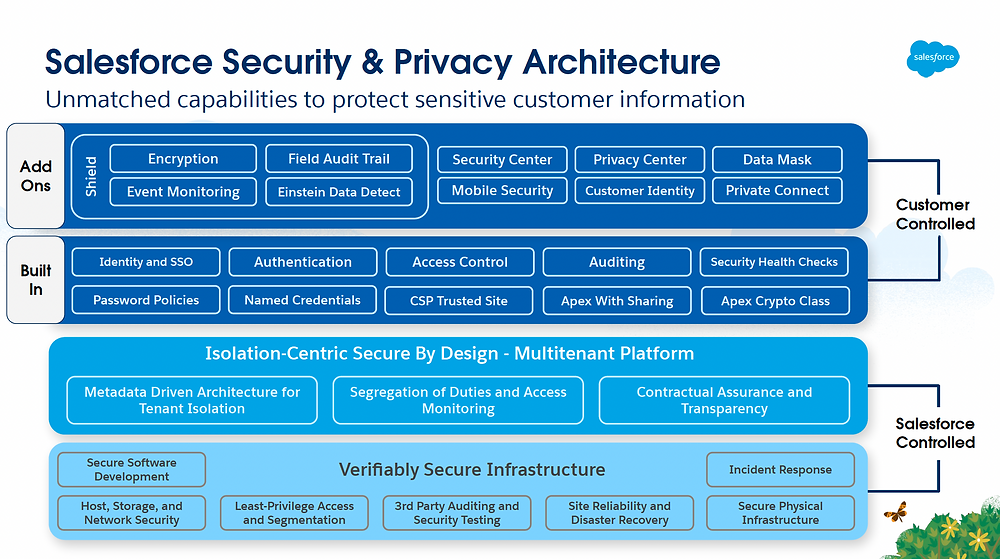A business must protect the security and privacy of data, especially when dealing with customer information. Salesforce a well-known Customer Relationship Management platform provides adequate measures, tools, and practices to protect your data. In this blog, we’ll walk you through how Salesforce keeps data secure and what steps you can take to enhance security on your own. Let’s get started!
What is Privacy and Data Security in Salesforce?
Data security is the practice of protecting your data from unauthorized access, while Data privacy is concerned with how personal information is collected, stored, and shared – by privacy regulations such as GDPR and CCPA. Salesforce incorporates different levels of security architecture to protect the information. Knowing these features will secure your organization with data protection norms.

Why is Data Security and Privacy Important in Salesforce?
In Salesforce, Data Security and Privacy refer to keeping all such information about the company secure and ensuring it’s used properly, whether it be customer information, sales statistics, or sensitive business strategies.
They ensure that sensitive customer information is shielded from data breaches, and ensure compliance with global data protection laws. Data mishandling results in breaches leading to reputational loss and loss of trust from customers. Salesforce already has many built-in features and good practices to help you be more compliant and secure. Keeping your data safe is critical because:
- It helps build trust with your customers.
- You stay within the rules of global laws (like GDPR and CCPA).
- It prevents hackers from stealing your info.
- It ensures people’s data is protected
Key Features of Data Security in Salesforce
- Role-Based Access Control: Allow or restrict access to certain information among employees based on their roles (e.g., the ability of an admin to view everything vs. a sales rep who can only see customer profiles).
- Data Encryption: Both stored and shared data are locked and safe when shared on the network so it is usually secured from unwanted readers.
- Two-Factor Authentication (2FA): Identification for a single account can take two steps, one being the input of the correct password and the other a mobile device, therefore further securing the account
- IP Whitelisting: Allows Salesforce only to be accessed from your trustworthy places (for ex – your workplace), thus decreasing unauthorized access.
- Field Level Security: This lets you determine which users can view or edit certain information it means you can keep sensitive information such as Social Security Numbers available only to a select few.
How Can You Implement These Security and Privacy Measures?
Now comes the fun part – putting these measures into action! Here are some practical steps:
Set up Strong Password Policies And MFA
- Use strong passwords and multi-factor authentication
- Using apps for the second factor as much as possible or SMS
Assign Field Level Security and Sharing Rules
- Manage who gets to see or edit particular fields
- Configure OWD (organization-wide defaults) and sharing Rules across the board for control of record access
Use Salesforce Shield
- Utilize Salesforce Shield to Encrypt Sensitive Data
- User activity monitoring and alerting based on behavior
Develop a Data Classification System
- Identify the sensitivity of the data (public, internal, classified)
- Implement flexible security controls according to classification
Implement a Data Retention Policy
- Specify how long data of each general type should be retained
- Automate data deletion through Salesforce’s data management tools
Train Your Team
- Train all on the significance of data security and privacy
- Organize to run fun workshops or quizzes to maintain that awareness
Final Thoughts
Ensuring privacy and data security in Salesforce is not about using the right tools, it’s about understanding and applying best practices. By leveraging Salesforce’s built-in security features like role-based access control, encryption, and two-factor authentication, along with your organizational policies like strong password management and regular audits, you can significantly reduce risks and stay compliant with global data privacy regulations.
Here’s a checklist to help:
- Strong passwords and MFA
- Data encryption and access controls
- Privacy management tools in place
- Data minimization practices followed
- Regular security audits
- The team trained in security best practices
By following these steps, you can ensure that your Salesforce data stays safe and private!
Must Visit Links:-
- What is an AI Chatbot? Exploring the Future of Customer Interaction
- Top 5 Reasons to Use AI in CRM
- Top 5 Benefits To Customize CRM With AI Today! – Salesforce Trail
- Maximizing ROI with Einstein AI for Marketing Solutions
Resources
- [Salesforce Trailhead] (https://trailhead.salesforce.com/)
- [Salesforce Developer] (https://developer.salesforce.com/)
- [Salesforce Success Community] (https://success.salesforce.com/)
For more insights, trends, and news related to Salesforce, stay tuned with Salesforce Trail
Mark Jacobes is a seasoned Salesforce expert, passionate about empowering businesses through innovative CRM solutions. With over 6 years of experience in the Salesforce ecosystem, Mark specializes in Salesforce development, integrations, and digital transformation strategies.
- Mark Jacobeshttps://salesforcetrail.com/author/markjacobes/September 8, 2025
- Mark Jacobeshttps://salesforcetrail.com/author/markjacobes/
- Mark Jacobeshttps://salesforcetrail.com/author/markjacobes/
- Mark Jacobeshttps://salesforcetrail.com/author/markjacobes/







